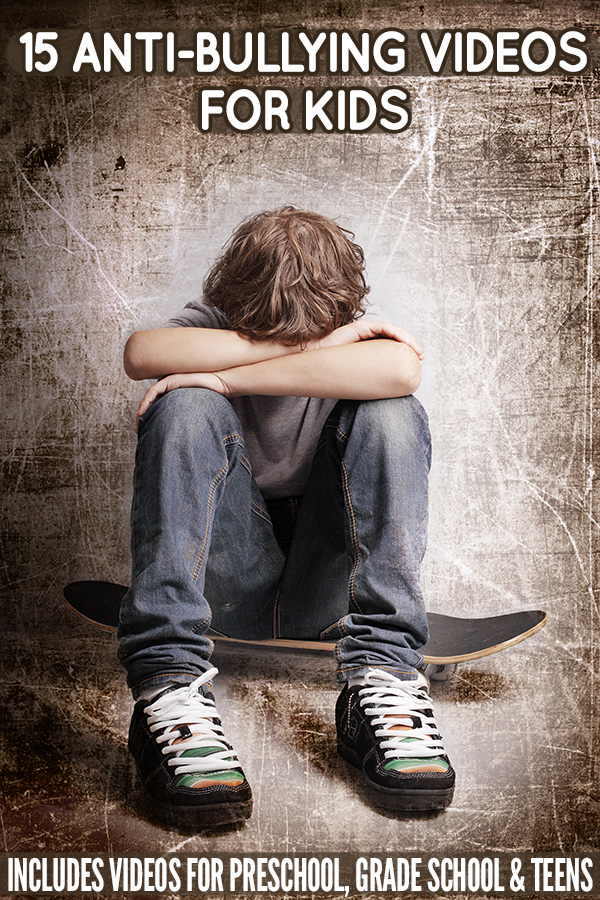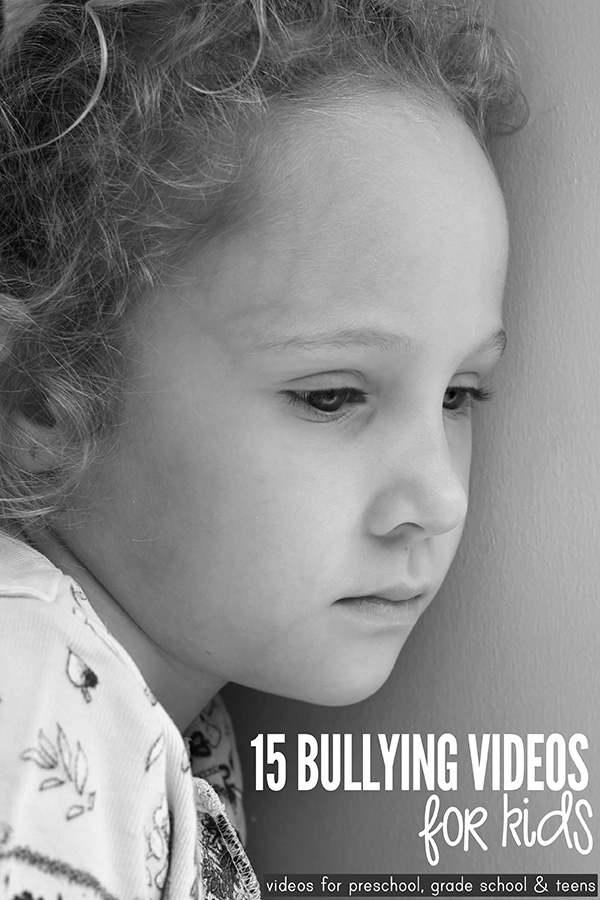15 Anti- Bullying Videos for Kids Age 4 – 12+ Years
Bullying is an age-old problem and comes in many forms, especially in today’s digital world. The good news is that there are many fabulous anti-bullying resources available for parents and teachers to use at home or school.
Each of the videos featured in this collection of 15 anti- bullying videos is perfect for inviting discussion about the problem of bullying, as well as providing strategies to help build the child’s confidence about managing a range of bullying situations.
15 Anti- Bullying Videos for Kids
The videos are divided into three age ranges – 4-7 years, 7-11 years and 12+ years.
Anti- Bullying Videos For Young Children (Ages 4 – 7)
Children this age are still learning a lot about getting along with others. Although we may be hesitant to label behaviors, many experts agree that children as young as three should learn the difference between “rough play” and actions that intentionally hurt others.
1. Yes, That’s Bullying
This one-minute animated video introduces the term “bullying” to young children and identifies several actions that qualify, including the use of hurtful words. Young children will relate to the animal characters participating in art class and appreciate the teacher’s clear explanation of the difference between treating others with kindness and respect and harming others with words or actions. Produced by the U.S. Department of Health and Human Resources, a transcript of the video is available here on the Stop Bullying website.
2. Preschool Anti-Bullying
When preschoolers are treating one another badly, this positive two-minute video about friendship can turn it around! Set to Randy Newman’s song, “You’ve Got a Friend in Me,” this video shows preschoolers treating one another kindly in many different ways. Teachers could introduce the video by asking children to look for all of the ways that the children are getting along, sharing, and “being nice.”
3. Bully: A Read-Along Story
In this story, Billy learns that kindness can be some solution to mean and bullying behaviours. He decides to be kind rather than standing up to the bully, and the two end up as friends. This is a great video to share with younger children to teach empathy and kindness in responding to bullying behaviors.
4. The Playground is for Everyone
The story in this animated video will be familiar to many children and explains social exclusion, as a type of bullying. Several animal characters on a playground try to prevent others from playing on the climbing bars. When one student steps in and stands up for the victim, the teacher overhears and explains that excluding someone socially is a form of bullying. The teacher also praises the student who stands up to the bullies as an ally. Also produced by the U.S. Department of Health and Human Resources, this is another great resource for use with very young children.
5. Sesame Street: Don’t Be a Bully
Animals of the famous Muppet group react to unfairness on the playground by singing a song, “Don’t Be a Bully,” in this Sesame Street clip. A simple way to reinforce the idea of not being a part of bullying, this will resonate with very young children.
Anti-Bullying Videos For Students (Age 7 – 11)
Children at this age like to engage in stories that allow them to see themselves and mentally rehearse responses to difficult situations. These videos address the types of bullying that most often affect children in this age group: physical aggression, social exclusion, and verbal abuse.
6. What is Bullying (The Basics)
An excellent place to start, this video is an episode of Rocket Kids, character education videos that teach life skills. Elvis, the student who narrates the video, explains exactly what behavior qualifies as bullying and discusses the difference between conflict and bullying. The video describes four types of bullying: physical, verbal, emotional and cyber, and ends with the offer of further resources available here.
7. McGruff, the Crime Dog: Anti-Bullying Video
McGruff has been around for more than three decades, and according to the U.S. National Crime Prevention Council, surveys show that kids really listen to this cartoon crime dog! In this anti-bullying episode, McGruff introduces a three-step strategy kids can use in dealing with verbal bullying; the steps are “Stop, Talk, and Walk.” The video also includes a scene in which McGruff explains the importance of standing with a friend who is being bullied as a way to promote a safer community for all.
8. Strength in Numbers
Created by an elementary school as part of their anti-bullying campaign, this video is powerful in that the message is told through written signs placed on a girl’s body as she rides the bus, attends class, and goes to recess. In the classroom, this would be a great prompt for written reflection followed by discussion.
9. Leaving a Positive Footprint
Classroom teachers will also appreciate this video in which sixth graders teach first graders about being “upstanders,” those who stand up and work to stop bullying when they see it. Both older and younger students describe experiences with bullies, then work together to create paper footprints with positive messages to post around the school.
10. Bullying is Never Okay
A clear explanation of what constitutes bullying, the types of bullying and what to do if you are bullied, or see someone else being bullied.
Anti-Bullying Videos For Older Students (12 and up)
Young people at this age are well aware of specific types of bullying, particularly cyberbullying, and the social and emotional effects on victims. It’s important to discuss with preteens and teens how to be observant and aware of situations around them and how to be a positive influence in their schools.
11. Bystander Video
This video introduces the idea of being an “upstander” rather than a bystander, and presents statistics that show the profound impact one person can have in diffusing bullying situations. Although very short, just a minute and a half in length, it makes a powerful case for standing up for others and lists strategies to use such as changing the subject, using humour, etc.
12. Are Your Words Doing Damage?
This powerful piece about the relentlessness of cyberbullying, and how easily it can be hidden from or missed by family, was created by a fifteen year old in an effort to call out the dark world of online bullying and to expose the issues that modern children face.
13. Pupils
An insightful, award winning short film depicting a bullied boy surrounded by those blinded to his plight. Ultimately, he must decide whether to be a victim, or a hero. A great resource for sparking discussions with older students about the role of bystanders and why they think others (both peers and adults) miss the clues that a person is being bullied.
14. ReThink Before the Damage Is Done
As a 13 year old Trisha Prabhu sought to find a way to practically help stop cyberbullying. In her TEDxYouth Talk, Trisha shares the research she undertook and the practical solution she has developed. This provides a great jumping off point for talking with teenagers about the real impact of their choices, actions and words, and the permanency of what is shared on the internet.
RELATED: 10 Growth Mindset TedTalks to Share With Your Students
15. If You’re Being Bullied, Don’t Give Up
A powerful and supportive message for victims of bullying that includes suggestions for how to get through the difficult moments when you’re feeling bad about yourself and the situation – just five minutes at a time.
Additional Anti-Bullying Resources
Here are a few additional videos and resources useful for use at home or school:
For Parents:
- Back to School: How to Deal with Bullying and Meanness : I Parents
- When Your Child Experiences Bullying: Part 1 : PACERTalks About Bullying
For Teachers:
- Bullying. No Way! (Resources for Australian classrooms)
- Elementary School Activities (Stop Bullying)
- Elementary Lesson Plan: Introduction to the Dynamics of Bullying
- Bully-Free Zone (Anti-Bullying Song for Kids)
If you are a child needing help because you are being bullied, please speak to a trusted adult immediately, or call one of the following helplines for assistance;
In Australia:
Kids Helpline: 1800 55 1800
Headspace: 1800 650 890
In USA:
Stop Bullying Now Hotline 1-800-273-8255
In UK:
Childline: 0800 1111
In Canada:
800-688-6868
 Up next:
Up next:
10 Strategies for Supporting the Emotional Wellbeing of Students




